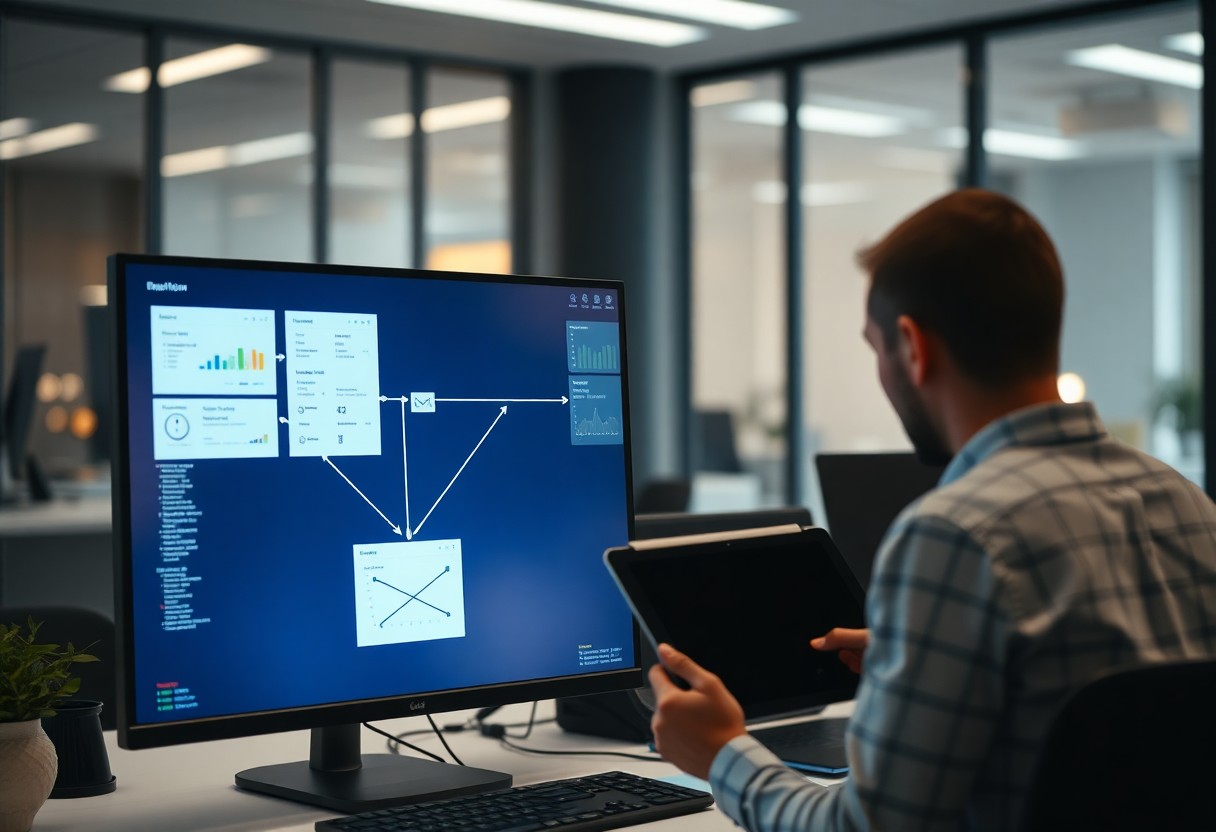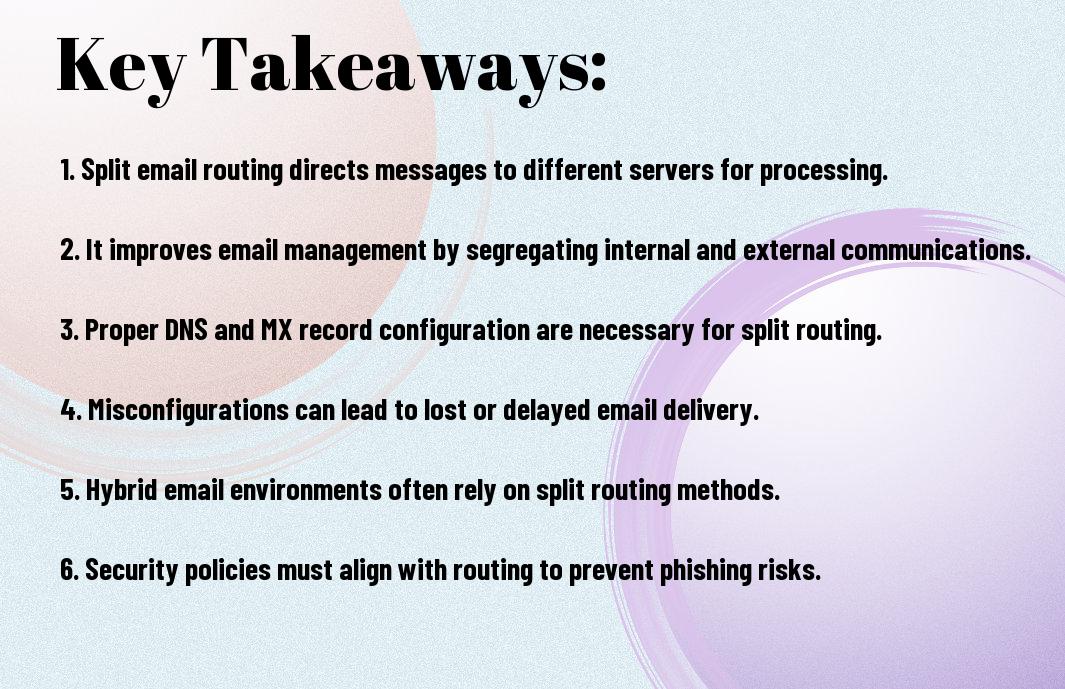With the increasing complexity of email communications, understanding the intricacies of split email routing techniques becomes imperative for optimizing your messaging strategies. You may find yourself navigating through various methods of routing, ensuring that your emails are delivered efficiently and effectively to your desired audiences. This post will shed light on the different nuances of split email routing, helping you enhance your email delivery practices and tailor your approach to meet specific organizational needs.
Key Takeaways:
- Split email routing involves directing incoming emails to different servers or endpoints based on specific criteria.
- Understanding the differences between split routing techniques, such as geographical or departmental routing, can enhance email management.
- Implementing these techniques can improve email deliverability and ensure efficient handling of messages.
- Monitoring and analyzing email traffic are vital for optimizing routing strategies and maintaining system performance.
- Documentation and training for team members are important for effective implementation and use of split email routing practices.

The Mechanics of Split Email Routing
Incorporating split email routing requires a firm grasp of how differing servers interact and relay information effectively. By harnessing specific routing rules, administrators can direct emails based on various criteria such as sender domain, recipient address, or even the content within the message. This setup enhances organizational efficiency and helps manage workload distribution across multiple mail servers.
How Split Email Routing Works
Split email routing operates by utilizing predefined filters that assess incoming emails and determine their destination. For example, an email from a client might be routed to a specific team’s inbox based on the project code in the subject line. By employing such criteria, you can ensure that communications are directed to the most appropriate teams in real-time.
Technical Variations and Configurations
Diverse configurations of split email routing exist to match various organizational needs and preferences. You can integrate protocols like SMTP alongside advanced tools such as mail gateways or cloud-based software solutions. These variations often include time-based routing, geographical considerations, or load balancing for peak times, allowing your email infrastructure to adapt seamlessly to dynamic workloads.
For instance, employing load balancing can significantly improve performance during high traffic periods, distributing emails evenly among servers. You could implement time-based routing to send alerts or updates in line with your business hours. This flexibility is crucial in maintaining effective communication, especially in organizations that operate across multiple time zones. Overall, the configuration can not only optimize delivery times but also improve the security and reliability of your emails.

The Strategic Importance of Routing Decisions
Routing decisions impact how effectively your emails reach intended audiences while meeting organizational goals. Each routing choice determines not only the flow of information but also influences recipient interactions and overall satisfaction. Misguided routes can lead to delays or lost messages, thereby jeopardizing customer relationships and trust. Additionally, capturing the right metrics through strategic routing can provide valuable insights into recipient behavior and preferences, enabling you to optimize future communications for heightened engagement and success.
Enhancing Deliverability and Engagement
Effective routing can significantly improve email deliverability rates by minimizing the likelihood of spam filters flagging your messages. By segmenting your audience and directing content based on user behavior or preferences, you create a more personalized experience that resonates with recipients. This tailored approach not only encourages higher open and click-through rates but also fosters a sense of connection, thus promoting a more engaged audience over time.
Cost-Benefit Analysis of Routing Techniques
Understanding the financial implications of your routing choices is imperative for maximizing email performance. While some advanced routing techniques may demand a higher initial investment, the long-term ROI could be substantial when considering factors like reduced bounce rates and improved customer satisfaction. Analyzing metrics such as increased conversion rates and lowered unsubscribe counts will provide clearer visibility into how your routing strategies align with your overall marketing budget and objectives.
Conducting a thorough cost-benefit analysis involves evaluating both direct and indirect costs associated with your routing techniques. For instance, implementing automated routing systems may incur upfront software costs but can lead to labor savings through reduced manual oversight and increased responsiveness. On the flip side, poorly routed campaigns can result in lost revenue due to missed opportunities or disengaged recipients. Tracking these metrics over time empowers you to refine your strategies and justify expenditures based on their performance outcomes.
Common Pitfalls and Misunderstandings
Your grasp of split email routing may be challenged by several common pitfalls that can undermine its effectiveness. Misunderstanding the criteria for routing can lead to unintended consequences, such as delivering sensitive information to the wrong recipient or causing delays in important communications. Awareness of these pitfalls is key in optimizing the routing process for consistency and accuracy.
Misconfigurations That Can Hurt Performance
Configuration errors can severely impact the performance of your email routing setup. A simple misplaced setting could result in emails being sent to offline servers or causing routing loops. These misconfigurations not only hinder efficiency but may also lead to increased bounce rates. Regular audits and testing of your configuration can prevent these performance issues from surfacing.
Overlooking User Experience in Email Delivery
Failing to consider user experience when implementing split email routing techniques can be detrimental. If users encounter delays or inconsistent delivery times due to complex routing setups, their perception of your communication reliability may suffer. Prioritizing user experience means analyzing the end-to-end email journey and ensuring that delivery times remain quick and consistent, keeping users engaged and satisfied.
An effective split email routing strategy should seamlessly integrate into your existing communication practices without compromising user experience. For instance, implementing routing based on real-time server capacity can help maintain quick delivery times, while an intuitive dashboard for users can enhance their interactions. Evaluating your routing methods through user feedback can also reveal areas for improvement, ensuring that the experiences you provide meet or exceed expectations. Involving users in testing phases will highlight potential friction points in the delivery process and clarify how different routing strategies impact their experience.

Advanced Techniques for Optimizing Email Routing
Optimizing email routing involves advanced strategies that enhance delivery efficiency and engagement. By implementing these techniques, you can maximize the effectiveness of your email campaigns and tailor them to your audience’s preferences.
- Utilize domain authentication to boost deliverability.
- Segment your audience based on behavioral data.
- Implement geolocation targeting for localized content.
- Use real-time monitoring to adjust routing dynamically.
- Incorporate feedback loops for continuous improvement.
| Optimization Technique | Description |
|---|---|
| Domain Authentication | Ensures emails are verified to increase trust and deliverability. |
| Audience Segmentation | Divides subscribers into specific groups for targeted messages. |
| Geolocation Targeting | Delivers region-specific content to enhance relevance. |
| Real-Time Monitoring | Adjusts your routing strategy based on live data insights. |
| Feedback Loops | Incorporates user feedback to refine and optimize future campaigns. |
Leveraging AI and Machine Learning
Integrating AI and machine learning into your email routing can significantly enhance your campaigns. These technologies analyze vast amounts of data to predict the best delivery times, segment audiences more accurately, and even customize content based on user behavior, leading to improved open and click rates.
A/B Testing and Continuous Improvement Strategies
A/B testing allows you to experiment with different email routing strategies to determine which approach yields the best results. By comparing various subject lines, sender names, and sending times, you gain insights that enable ongoing refinement of your email marketing efforts.
Consider employing A/B testing not just for simple elements like subject lines, but also for routing strategies themselves. For instance, you might test two different segmentation strategies to see which yields a higher open rate. Continuous monitoring post-test can reveal trends that inform your broader strategy, ensuring your email routing evolves in line with changing subscriber preferences and behaviors. This iterative process fosters sustained growth and relevance in your email campaigns, encouraging greater engagement and conversions over time.
The Future of Split Email Routing
Advancements in split email routing technology are set to redefine email management, as organizations increasingly prioritize security, efficiency, and flexibility in their communication systems. In the coming years, you can expect enhanced automation capabilities, integrating machine learning to optimize routing decisions in real-time and boost productivity. Additionally, with the rise of hybrid work environments, organizations will adopt more dynamic routing strategies accommodating both cloud-based and on-premise solutions.
Emerging Trends in Email Technologies
New technologies are reshaping email routing practices, with AI-driven solutions leading the charge. Predictive analytics are becoming increasingly vital in determining the best path for your emails based on historical data and usage patterns. Enhanced security features such as advanced threat detection and user behavior analytics will also ensure that your email communications remain protected amidst evolving cyber threats.
Predictions for Industry Evolution
Experts anticipate that split email routing will evolve into a more intelligent, adaptive framework as organizations embrace a zero-trust security model. The integration of advanced technologies, such as natural language processing and real-time data analysis, will enable more customized and reliable routing options tailored to specific needs. This shift will enhance decision-making in email communications and reduce operational costs associated with email management.
As the industry adapts to these changes, you can anticipate a landscape where automation not only streamlines routing processes but also empowers you with analytics and insights to make informed decisions. With the potential to effectively manage high volumes of incoming emails through AI and machine learning, you’ll find that your communication strategies become more agile and responsive. The future of split email routing is likely to align seamlessly with cloud infrastructure and interconnected systems, further simplifying your email management while ensuring compliance and security remain a top priority.
Final Words
To wrap up, understanding the nuances of split email routing techniques can significantly enhance your email management strategy. By knowing how to implement these techniques, you can better control where your emails are delivered and optimize your communication flows. If you’re looking for specific guidance on configuring these settings, make sure to explore the available Email routing and delivery options for Google Workspace. This knowledge will empower you to make informed decisions for your organization’s email infrastructure.
Q: What are split email routing techniques?
A: Split email routing techniques refer to methods used to direct incoming emails to different servers or destinations based on specific criteria such as sender domain, content, or other attributes. This method allows organizations to manage their email flow more efficiently, ensuring that specific emails are processed by the appropriate systems or teams.
Q: How does split email routing enhance email management?
A: By employing split email routing, organizations can improve their email management processes by segmenting incoming emails based on defined rules. This segmentation can reduce server load, minimize processing times, and streamline workflows by directing relevant emails to the correct departments or systems for faster response rates and better service quality.
Q: What criteria can be used for split email routing?
A: Various criteria can be applied in split email routing, including sender email domain, keywords or phrases within the email subject or body, geographic location of the sender, and user-defined rules based on business needs. By establishing clear routing criteria, organizations can ensure that emails are efficiently categorized and delivered to the right recipients.
Q: What challenges might arise when implementing split email routing techniques?
A: Implementing split email routing techniques can present challenges such as the complexity of rule creation, potential misrouting of emails, and the need for ongoing maintenance to adapt to evolving business needs. Additionally, organizations may encounter issues with email security and spam filtering, which must be addressed to ensure a smooth routing process.
Q: How can organizations optimize their split email routing strategies?
A: Organizations can optimize their split email routing strategies by conducting regular audits of their routing rules, utilizing analytics to assess the effectiveness of their current setup, and continuously adapting their criteria based on performance metrics and user feedback. Integrating advanced technologies, such as machine learning, can also improve the accuracy and efficiency of email routing over time.

